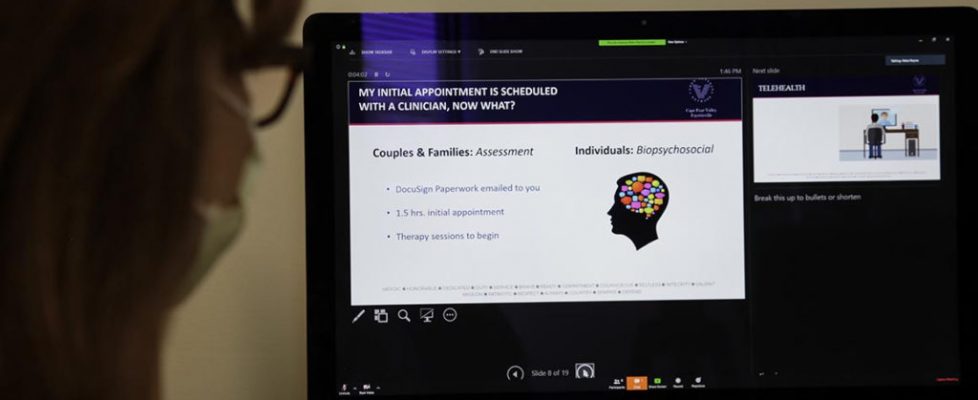‘Virtual Hospital’ Model Passes Test in COVID-19 Patients
Only a few patients with COVID-19 pneumonia required hospitalization when they received care in a “hospital at home” (HaH) telemedicine program, researchers at one health system reported.
Of nearly 1,500 patients enrolled in the program, 40 required hospitalization and eight needed ventilation; just two patients died, reported Kranthi Sitammagari, MD, of Atrium Health in Monroe, North Carolina, and others from Atrium where the HaH program was implemented. Their findings appeared in Annals of Internal Medicine.
The dual-acuity program used a symptom scoring algorithm to determine placement. Patients with lower scores entered a “virtual observation unit” (VOU) and got one nurse phone call each day. Sicker patients and those with disease progression — who would normally be admitted to the real hospital — were assigned to a “virtual acute care unit” (VACU) and had at least thrice-daily monitoring with on-call provider access. The highest-acuity patients received telephone monitoring every 6 hours, and/or in-home visits. They could receive hospital-level care at home, including intravenous and respiratory therapy, or be directly admitted.
“By ‘forward triaging’ patients with virtual assessments and directly admitting patients from satellite testing centers … we kept patients out of the emergency department, thus minimizing exposure of health care staff and other patients in the traditional hospital setting,” they noted. “In addition, minimizing health care staff exposure meant that less personal protective equipment was needed at a time of scant resources.”
Atrium Health, a large integrated health care system, built its COVID-19 program on an existing HaH telemedicine program established 5 years ago. It targets patients at high risk for hospital readmission. Clinicians on a dedicated team provide round-the-clock virtual care for patients, with quick access to specialists. It also employs the two-tiered system in which lower acuity patients are treated in the VOU.
Staff put the COVID-19 arm together in just 2 weeks and began treating patients in March.
The current analysis covers 1,477 patients with COVID-19 pneumonia treated from March 23 to May 7, 2020. These represented “almost two-thirds” of all COVID-positive patients treated in the Atrium system, Sitammagari and colleagues indicated.
Most patients (88%) stayed in the VOU; 184 (12%) entered VACU care at some point. Those in the VACU had a monitoring kit comprising a blood pressure cuff, pulse oximeter, and thermometer delivered to their homes.
In the VOU group, 35% were Black and 32% white; in the VACU, 46% were Black and 30% white. Not surprisingly, given the patterns seen elsewhere in COVID-19, patients in the VACU were older than those in the VOU (median 54 vs 43 years), and more likely to have comorbid conditions such as asthma, congestive heart failure, diabetes, COPD, or obesity.
Forty VOU patients (3%) were admitted to a real hospital, with 16 admitted to the intensive care unit and seven requiring machinal ventilation. Two patients died. In the VACU, 24 (13%) were hospitalized, 10 admitted to the ICU, and one given mechanical ventilation. There were no deaths in the VACU group.
The median HaH stay was 11 days for treated solely in the VOU and 12 for those who spent any time in the VACU. The median VACU stay was 2 days.
Atrium’s experience demonstrates that telemedicine increases a system’s ability to care for COVID-19 patients without sacrificing much-needed hospital beds for less-acute patients, even in an intensifying pandemic, Sitammagari and his colleagues concluded.
“[A]ll 160 VACU patients who did not require transfer to a brick-and-mortar hospital can be viewed by extension as traditional hospital beds saved,” the group wrote. “The [program] maintained a consistent patient census for the first 6 weeks as COVID-19 cases spread locally, with built-in capacity to expand its census by another 10-fold as a safety net for the system.”
As well, they noted, “minimizing health care staff exposure meant that less personal protective equipment was needed at a time of scant resources,” and providers at risk themselves for infection were spared from having to care for patients in-person.
“Finally, we expect to realize the potential long-term benefits a virtual hospital may provide in terms of reduced health care costs, reduced readmissions, and improved patient health outcomes for non–COVID-19 diagnoses,” Sitammagari and his colleagues wrote.
Excellent clinical outcomes are, of course, the most important result of this study, commented Tufia Haddad, MD, medical director of the Mayo Clinic’s Center for Connected Care’s Remote Patient Monitoring team in Rochester, Minnesota.
“What I really love about this is they had the ability to do hospital-level interventions at home, giving flexibility of care rather than the absolute need to bring the patient to the hospital. That’s a real strength of this program,” Haddad told MedPage Today.
Her team is preparing to publish its own results, but she said the Mayo group’s overall admission rate is similar to the 3% noted in the Atrium study. Early identification of decompensation is the key to success in these models, she added.
The Atrium team didn’t report specific financial outcomes, but telemedicine programs are generally associated with cost benefits for patients, hospitals, and payers, Haddad said.
“The Centers for Medicare and Medicaid Services does recognize remote patient monitoring as a billable service, so there’s a growing recognition that this is a validated model of care,” she said. “If we are able to keep patients at home and out of the ICU or ED, that’s a major savings for everyone.”

